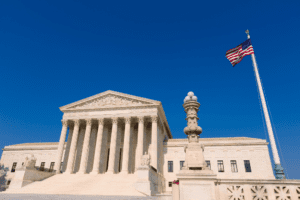 Justice Breyer continued: The Court also suggests that laws that were enacted before firearms arrived in England, like these early edicts and the subsequent Statute of Northampton, are irrelevant. Ante, at 32. But why should that be? Pregun regulations prohibiting “going armed” in public illustrate an entrenched tradition of restricting public carriage of weapons. That tradition seems as likely to apply to firearms as to any other lethal weapons—particularly if we follow the Court’s instruction to use analogical reasoning. See ante, at 19–20. And indeed, as we shall shortly see, the most significant pre-firearm regulation of public carriage— the Statute of Northampton—was in fact applied to guns once they appeared in England. See Sir John Knight’s Case, 3 Mod. 117, 87 Eng. Rep. 75, 76 (K. B. 1686)
Justice Breyer continued: The Court also suggests that laws that were enacted before firearms arrived in England, like these early edicts and the subsequent Statute of Northampton, are irrelevant. Ante, at 32. But why should that be? Pregun regulations prohibiting “going armed” in public illustrate an entrenched tradition of restricting public carriage of weapons. That tradition seems as likely to apply to firearms as to any other lethal weapons—particularly if we follow the Court’s instruction to use analogical reasoning. See ante, at 19–20. And indeed, as we shall shortly see, the most significant pre-firearm regulation of public carriage— the Statute of Northampton—was in fact applied to guns once they appeared in England. See Sir John Knight’s Case, 3 Mod. 117, 87 Eng. Rep. 75, 76 (K. B. 1686)
The Statute of Northampton was enacted in 1328. 2 Edw. 3, 258, c. 3. By its terms, the statute made it a criminal offense to carry arms without the King’s authorization. It provided that, without such authorization, “no Man great nor small, of what Condition soever he be,” could “go nor ride armed by night nor by day, in Fairs, Markets, nor in the presence of the Justices or other Ministers, nor in no part elsewhere, upon pain to forfeit their Armour to the King, and their Bodies to Prison at the King’s pleasure.” Ibid.
For more than a century following its enactment, England’s sheriffs were routinely reminded to strictly enforce the Statute of Northampton against those going armed without the King’s permission. See Calendar of the Close Rolls, Edward III, 1330–1333, at 131 (Apr. 3, 1330) (1898); 1 Calendar of the Close Rolls, Richard II, 1377–1381, at 34 (Dec. 1, 1377) (1914); 2 id., Richard II, 1381–1385, at 3 (Aug. 7, 1381) (1920); 3 id., Richard II, 1385–1389, at 128 (Feb. 6, 1386) (1921); id., at 399–400 (May 16, 1388); 4 id., Henry VI, 1441–1447, at 224 (May 12, 1444) (1937); see also 11 Tudor Royal Proclamations, The Later Tudors: 1553– 1587, pp. 442–445 (Proclamation 641, 21 Elizabeth I, July 26, 1579) (P. Hughes & J. Larkin eds. 1969).
Once again, in picking on Justice Thomas’s reasoning, the dissent indirectly makes a point of favor of expansive rights to carry firearms. The old English laws cited were motivated by the king’s desire to maintain power over his subjects. A hallmark of this tyranny is prohibiting the right to carry firearms. Thus, an expansive right to carry a firearm is consistent with the Constitution and Second Amendment that were designed to keep the Government’s power in check.
